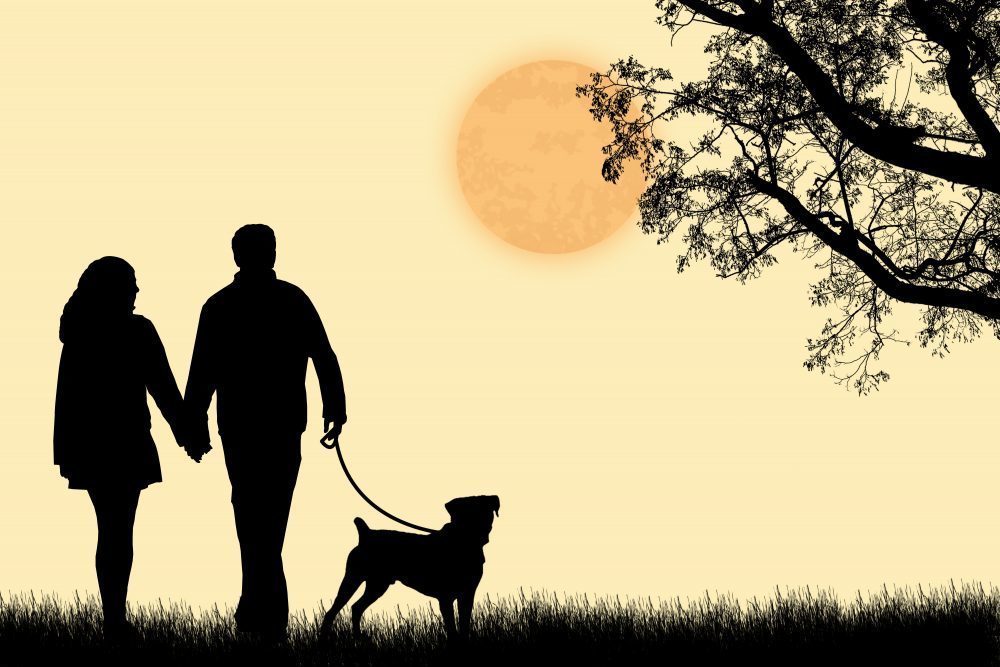If you’re in the habit of walking your dog when it’s dark out, be sure to follow these steps to keep him – and yourself – safe.
If you’re like a lot of people, your busy lifestyle means you sometimes end up walking your dog very early in the morning or late in the evening, when it’s dark or dusky out. This may be especially the case now that the days are starting to shorten again as we head toward autumn. When visibility is low, you have to take your dog’s safety, and your own, into a little more consideration. Here are some suggestions to ensure your nocturnal outings remain safe and enjoyable for you and your dog.
On reflection
One of the most important things is to make sure you and your dog are going to be visible to passing traffic. Keep in mind that, depending on weather conditions, it can be almost as hard to see during the half-light of pre-dawn or dusk as when it’s completely dark. Wear lighter-colored clothes that will show up better (black or gray aren’t good choices), ideally with reflective fabrics or trim. Fit your dog out with a jacket, sweater, collar or leash that also incorporates easy-to-see reflective features.
Light the way
A flashlight or headlamp will make you even more visible. A handheld flashlight may not be the best option when you’re also holding your dog’s leash, but you can buy lights that clip to your belt. Lights that flash will increase your visibility. For your dog, purchase an LED collar, harness and leash made specifically for nighttime walking.
A handheld flashlight may not be the best option when you’re also holding your dog’s leash, but you can buy lights that clip to your belt.
Dress accordingly
The night hours, especially those just before dawn, are the coolest. This can make nighttime walking a welcome relief during the summer, when daytime temps are often too hot for much outdoor exercise. Once we get into the fall, though, it can get quite chilly when the sun is down, so be sure to dress accordingly and fit your dog out with a jacket or sweater.
Protect against mosquitoes
Depending on where you live, dawn and dusk are when mosquitoes are most active during the warm weather months. Make sure to use a safe and natural bug repellent to protect both you and your dog if you decide to walk him during these times. You can buy natural sprays and lotions that are safe for pets, or make your own: a few drops of an essential oil such as lavender, eucalyptus or rosemary diluted in water in a spray bottle makes a simple and effective repellent that can be applied to your skin and your dog’s coat.
Keep him leashed
It’s very important to keep your dog on the leash when you’re walking at night. When visibility is limited, he can wander out of your sight in no time, which means you can’t keep track of where he is or what he’s doing – he could run into traffic, start chasing a rabbit, or get into someone’s garbage before you know it.
 Watch for wild animals
Watch for wild animals
Coyotes, raccoons, skunks and other critters are often most active at night, another good reason to keep your dog leashed. Stick to more built-up, well-lit areas – you’ll be less likely to encounter a wild animal there than in secluded or wooded spots. If you do happen to spot any wildlife while out for a walk, alter your route so your dog doesn’t come into contact with it.
Consider personal safety
Many people assume they’ll be safer if they have a dog with them when they walk at night. But not all potential human predators are put off by dogs, and not all dogs will protect their people if they’re threatened or attacked by someone. Play it safe, especially if you’re a woman, by avoiding dark paths and empty parks, and staying in busier, well-illuminated areas.
Leave the tunes at home
When it’s hard to see, you need to rely more on your hearing to know what’s going on around you. Don’t wear headphones when walking your dog at night, so that you can pick up on auditory cues in your environment, such as a cyclist whizzing up behind you or an animal rustling in the bushes.
Don’t wear headphones when walking your dog at night, so that you can pick up on auditory cues in your environment.
Take your phone
Taking a cellphone with you on night walks means you can quickly call for help if you need it. Chances are, if you take the proper precautions, you won’t ever have to use it, but having a way to contact others if the need ever arises will give you (and your family back home) peace of mind.
Stick to known routes
Nighttime isn’t the right time for exploring new trails and streets. Leave it for the daylight hours, and stick to routes you know like the back of your hand. Being familiar with an area means you’re much less likely to run into unforeseen difficulties, or get lost.
Now you can enjoy!
Once you’ve taken all the right precautions for your safety and your dog’s, it’s time to relax, step out, and enjoy your walk!








